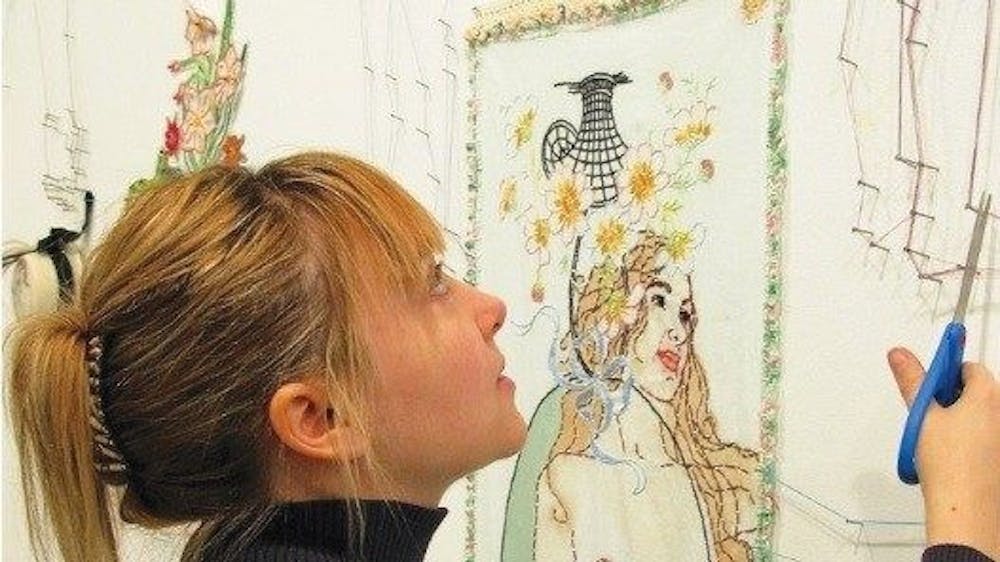The University of New Hampshire (UNH) Museum of Art, located in the Paul Creative Arts Center (PCAC), is currently exhibiting work by fibre artist Orly Cogan. Cogan has been exhibiting work for over two decades, during which she “has been at the forefront of the fiber arts movement,” according to her website (orlycogan.com/about).
Cogan’s work consists of vintage fabrics that she repurposes into elaborate, embroidered pieces. Her embroidery depicts human figures in an array of poses and situations, surrounded by and superimposed over images of plants, animals, food and other patterns.
“I was really taken with Orly’s process,” Museum Director Kristina Durocher said. “As you can see, it’s textile and embroidery, and I always try to provide a range of exhibition processes, or artist processes, in the exhibitions that I organize for the museum.”
Textile-based work is not extremely common for the university’s museum, and Durocher later added that the institution has not seen a purely textile exhibition in nearly 10 years.
Cogan visited the university on Thursday, Sept. 5, to give an informational talk about her work and background as an artist. During this talk, Cogan cited her family as inspiration for her subject matter and materials.
“My parents collected art,” the artist shared to a crowd of approximately 50 attendees. “My father’s side of the family collected Rubenesque type paintings where there were lots of figures interacting in dramatic scenes, and my mother’s side of the family was more interested in folk art, collecting quilts, old samplers and small embroideries.”
In her youth, Cogan attended The Rudolf Steiner School, which she also credits for her artistic inclination. “The wonderful thing about the school I went to is that the creative arts were held in the same high regard that the academics were,” she said. “They saw that I was going in that direction and encouraged it.”
Cogan also finds inspiration in feminist issues of the modern day as well as throughout history, basing the majority of her work on the intersection of these two themes.
Textile work has not always been respected as an art form throughout history, she explained. “It wasn’t respected as a high art that would be on gallery walls; it would just be something to feminize the home or something to busy womenfolk while the men were, y’know, doing the real work.”
In her work, Cogan aims to repurpose these old, disrespected fabrics to reflect the complex lives of modern-day women.
“I update the content of the vintage embroidery to incorporate the unladylike reality and wit of contemporary women; their struggles and the stereotypes which must now be overcome,” her official artist statement reads.
Cogan believes that her work, with its feminist themes, has great social value in today’s political climate.
“Everything I do is politically driven and feminist driven,” she said. “Especially in today’s society, where I feel like the current administration is doing their best to roll things backward, it’s very important that we continue this kind of work going forward. And a lot of [my pieces] have sort of hidden political areas within the storytelling of each piece.”
She later pointed out a small girl in her 2019 piece “The Feast” with the words “Me Too” embroidered onto her dress, a reference to the ongoing “Me Too” movement against sexual harassment and assault.
“Students at the university are dealing with all kinds of issues in building their identity,” Durocher said. She believes Cogan’s themes of feminism and identity make the exhibit and important presence on campus. “Having exposure to an artist who is wrestling through many of those same issues is really helpful for the students to see.”
Liese Zahabi, an assistant professor of art, art history and design, sees additional value in exhibiting Cogan’s work on campus.
“It’s a kind of art you don’t necessarily see all the time, and that’s true I think both somewhat in subject matter but mostly in materiality. And so it’s nice to see that it’s not just the classic cannon of painting, and especially not the classic white male cannon of painting, that it’s something a little different,” she explained. “I think that’s probably the biggest value of showing students, not just art students but all students, like, ‘this is art too.’”
Cogan finds great enjoyment in viewer interpretation of her work. During her talk, an audience member asked about the meaning of a particular image in Cogan’s piece “The Feast” in which a woman’s eyes are completely hidden by her own hair. Cogan responded, “You tell me. What do you think it is?” and watched smiling as two audience members debated the image’s meaning between themselves.
“And that’s what’s so wonderful to me about art and about writing about art. The artist isn’t standing next to each piece of art in a museum and can’t explain everything,” she added. “I love what you said about it. It can be that, it can be something else.”
Cogan’s work will be displayed in the university’s art museum through Friday, Oct. 12.














